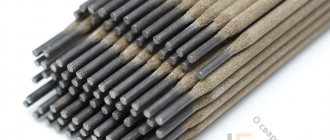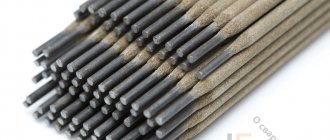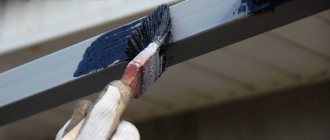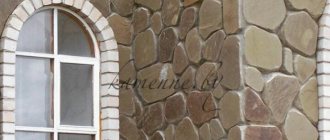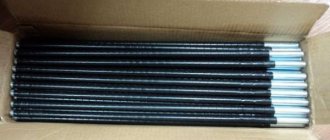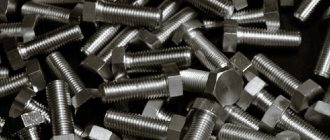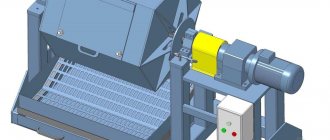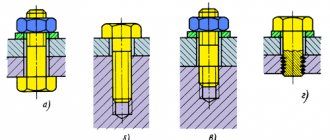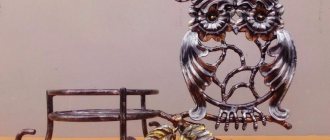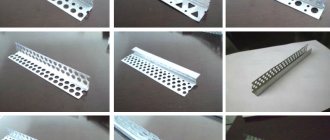Anti-corrosion metal coating is one of the most common ways to protect metal structures or communications from all kinds of negative external influences.
Protecting the coating from corrosion is the creation of an additional layer on the surface that prevents direct contact of the metal with air, moisture or water.
There are various types of anti-corrosion coatings, thanks to which you can successfully extend the life of metal devices.
Corrosion characteristics
Therefore, it is necessary to immediately discuss what corrosion is? This process is a specific chemical reaction. It occurs only when favorable conditions appear for this process.
Corrosion can appear on various metal surfaces if:
- the material will interact with water over a certain period of time,
- when the metal surface is in an open area,
- If all operating conditions have not been met, the metal itself is deformed, and its properties change so much that it becomes unsuitable for further use.
The metal, undermined by the external environment, crumbles and changes color and texture.
What do we offer
The AKRUS® trademark develops and selects protective compounds for individual orders with the required properties. We also have ready-made formulations suitable for even the most extreme operating conditions. We offer professional application of anti-corrosion coatings using specialized equipment, in full compliance with GOST paint and varnish standards and customer wishes.
Our specialists accompany all the necessary stages of work - from inspecting the objects being processed and their preparation to applying primers, finishing coatings and quality control of work.
Protection methods
Let's look at the measures to protect this seemingly stable material. The external environment can destroy it gradually, thanks to corrosion and rust that occurs as a result of a chemical reaction on the metal surface.
To prevent the spread of corrosion over the entire surface of the material, anti-corrosion coatings are used. These special metal protection products help slow down and further prevent the spread of rust through the metal. Such corrosion control products are affordable in terms of price. They are easy to find in a regular hardware store. This product quickly reacts with rust, affecting its foci.
Not only specialized paints and varnishes can be used as anti-corrosion protection agents. The most acceptable and cheapest means are paints and enamels with special chemical additives.
Such anti-corrosion measures also have a number of advantages:
- They are very easy to apply and use, do not require long training before use or a large team of specialists;
- They allow you to quickly and efficiently process metal structures of large dimensions and complex designs;
In addition, one should not deny the fact that the use of such coatings provides the following bonuses:
- You can get a coating of any color - just choose from the palette and order;
- Such coatings are quite cheap,
- They have high protection characteristics,
- If they are damaged during operation, they can be easily restored.
It is also worth noting that these anti-corrosion protection procedures are used primarily as a means of long-term insulation of metal elements present in the structure. This method of metal processing can be advantageously combined with decorative coating finishes. The aesthetic beauty of the appearance plays an important role in the overall result of the finishing work performed. After all, if the repair is done carelessly, it is possible that corrosion will return again after a while and bring even more problems associated with subsequent cleaning of the metal surface.
Processing rules
Before applying anticorrosive, it is necessary to prepare the surface. The requirements for surface preparation are as follows: .
- Any areas of rust or cracked paint or varnish must be removed.
- The surface must be cleaned of dirt, oils and dried.
- The anti-corrosion coating is applied using a special gun, or with a brush or roller.
All work on applying anticorrosive coating must be carried out regularly.
At enterprises where the exposure to an aggressive environment is too high, their exposure is reduced by:
- introduction of inhibitors;
- removing connections that are conductors of rust.
There are also SNiPs. Here are some of them.
- Impregnation of metal with a material with high chemical resistance.
- Pasting with special film.
- Use of paints and varnishes, oxide and metallized coatings.
Advantages of anti-corrosion coatings
The anti-corrosion coating has a whole range of positive properties.
Among them, the following stand out:
- resistance to water,
- resistance to various types of fuel,
- prevention of reactions with most chemical elements that can destroy the protective layer.
- electrical insulation,
- weather resistance.
Such materials are able to provide both passive and active protection against corrosion. As passive protection, a layer of paint and varnish physically isolates the metal from moisture. It is worth noting that the main types of paint protection used specifically for the passive protection of metal structures are materials using synthetic binders and alkyd-based paints. If you need a thin but high-quality coating, you should take a closer look at bitumen-based paints. If it is necessary to use it in an aggressive environment, at high temperatures, then you should pay attention to silicone enamels.
At the same time, active anti-corrosion protection itself implies the use of chemical inhibitors in paints that slow down the oxidation process of metals, as well as various other additives. It is worth noting that such coatings will last several times longer than any other layer of passive protection.
Types of anti-corrosion coatings
It is worth noting that there are different types of anti-corrosion coatings for metal. Anti-corrosion coatings to protect metal from the external environment are one of the most important areas of production activity in the paint and varnish industry.
Types of coatings and rules for their selection
Metal structures should be reliably protected from mechanical and chemical damage. Using anti-corrosion protection, you can preserve the original appearance of the material. You can also extend the life of the structure to 60 years. The protective layer is applied evenly and is resistant to high temperatures and chips.
One or another type of anti-corrosion protection must be chosen depending on the characteristics of the structure itself:
- galvanizing is a suitable option for small elements and products, but it is not suitable for repair work;
- nitriding - mainly used for the protection of tanks. The nitrite layer resists water, oil or gasoline well, but can be destroyed by acids or salts.
In addition to such anti-corrosion coatings, the following are popular in the domestic market:
- aluminizing (an alloy of iron and aluminum is used) - used to coat foundry equipment, pipes or sheet metal;
- chrome plating (consists of 60 percent ferrochrome) - protects parts of industrial equipment, pipes in heat exchange networks and auto parts;
- diffusion galvanizing (an alloy of aluminum and zinc) - in this case, the protective layer is applied in special rotary furnaces, then it is passivated and becomes more resistant to corrosion.
The simplest and most cost-effective method of creating anti-corrosion protection for metal is to coat it with special paints like Nerzhalux or Serebrol.
Metal products can be processed using plastics, in particular nylon or fluoroplastic.
However, whatever protection method you choose, it is important to properly prepare, clean or degrease the surface to be treated. This is the guarantee that the coating will be applied evenly and the service life will increase significantly.
Anti-corrosion metal coating
Often, in order to prevent the spread of corrosion through metal elements, it is necessary to comply with all operating rules that exist for a given device or part of a living space. Otherwise, no anti-corrosion paints will be able to hold back rust for a long time.
To begin with, you should ensure good ventilation in the room and at the same time take care of its tightness. This is especially true in the fall, when frequent rains and high humidity cause favorable conditions for corrosion.
Initially, a living space needs not only frequent cleaning and ventilation, but also full heating. Humidity should not be allowed to rise. Water is the first enemy of metal structures suffering from corrosion and rust, which provoked it.
It is important to remember that one coat of paint is insufficient protection of the metal from the harmful effects of the environment.
Therefore, it is better to spend more financial resources, but perform high-quality finishing work, which subsequently will not require repeated repairs, or a complete rework of the entire coating.
The thicker the protective layer, the better for the metal coating itself. However, too much paint should also not be applied. Three or four layers will be enough if the enterprise is industrial and the work here involves the development of chemical elements.
A few layers of paint can do more to protect a coating than hundreds of expensive paints with anti-corrosion additives.
The best universal anti-corrosion agents
The compositions are suitable for treating any external and internal surfaces. Their range is small, since manufacturers try to produce anti-corrosion agents for specific purposes. But buyers like to purchase a universal product that does not require costs. Such products are usually made in Russia.
Oilright
The Russian company offers several compounds that protect against corrosion. Anticorrosive Oilright Movil and Oilright Cannon lard is sold in 2 kg plastic cans. It is used to process thresholds, door frames, side members and other hidden car cavities. The layer also temporarily protects the wheel arches and underbody. As the manufacturer assures, the mixture can be applied to a damp and corroded surface. The product is used in molten form as a preservative and anti-corrosion coating.
Advantages
- Protects against rust;
- Has increased adhesion;
- Does not wash off with water;
- Low price;
- Suitable for any surface.
Flaws
- Poor external treatment.
To cover the bottom, it is better to choose hard cannon fat, and it is advisable to cover the internal cavities with soft one. This will create maximum protection and strength of the layer.
VELV "Movil-5E Extra"
This composition from a Russian company has been known since Soviet times. It perfectly pushes out water thanks to drying oil and oil. Many car enthusiasts, out of habit, choose domestic anticorrosion protection, since its price is very low. The mass is easy to apply, so no special skills are required. Anti-corrosion immediately stops the development of rust, but does not remove old corrosion. Unfortunately, the product is not able to dry completely, so it gradually flows down. Chemical reagents quickly destroy the applied composition.
Advantages
- Has hydrophobic properties;
- Low price;
- Easy to apply;
- Allows you to apply paint;
- Stops the development of corrosion;
- Available in any store.
Flaws
- Penetrates poorly;
- It flows down the walls.
According to car mechanics, it is worth buying more effective and durable compounds. A large pocket of corrosion under a layer of anticorrosion will most likely become damp and disappear.
What should you pay attention to?
However, excessive use of existing production volumes will not only lead to overspending and a large increase in the time required to dry the metal structure, but also, too thick a layer of paint often causes cracks in the coating that form during drying.
Much depends on the quality of the paint applied. If before applying the coating to the surface you notice that it is too liquid and spreads quickly, the manufacturer may have added an excessive amount of water. Then you will have to purchase another paint or you should add special substances to your existing paint to prevent excessive spreading of the paint material.
At the same time, if you apply paint very thinly, this can lead to ineffective protection of metal structures, which affects the molecular bonds of the paint coating, and also leads to too rapid destruction - that is, the paint will simply rub off and the original appearance of the coating will be lost.
Materials based on a polyurethane binder for cold galvanizing.
| Name | Application | Life time |
| Primers with a polyurethane binder | ||
| 88PU 1GS chemical resistant, single pack. | Used in complex coatings with enamels on a polyurethane binder and self-leveling floors. Creates a sealed, moisture-resistant film for copper and aluminum and their alloys, high- and low-alloy steel. The primer is technologically convenient to use: - due to its low viscosity, it is easy to apply, - dries quickly, - creates a strong elastic film with high adhesion to the next layer. | Together with anti-corrosion compounds, Politax-Anticor does not lose its protective properties for more than 10 years. The soil is safe in contact with food, drinking water, grain, and flour. |
| Epoxy primers | ||
| 88EP 2GS quick-drying, two-pack. | Used to create a corrosion-resistant coating with epoxy or polyurethane enamels: - with Politax 22EP 2KC enamel, resistant to strong and weak acids, - with Politax 22EP 2oil enamel, resistant to petroleum products, - with special ship enamel Politax 22EP 2S. | In direct contact with acids and alkalis for at least 5 years, with top enamel for more than 10 years. |
| Alkyd binder primers | ||
| 88AL 1GS phosphate, one-component. | The paint film formed is similar to the phosphate coating in a galvanic bath. Suitable for steel, aluminum, copper and their alloys. The primer can be applied as inter-operational protection for a period of 1 year. The film is matte light green in color. The primer goes well with the top coat of alkyd paint. | The service life of the coating system with Polytax 88AL 1GS primer is at least 10 years. |
Safety at work
In order to most effectively eliminate the likelihood of poisoning and illnesses arising from work related to the application of paint and varnish coatings, you will be required to strictly follow safety regulations.
First of all, in the rooms where work will take place, it is necessary to ensure good ventilation. Then, if this is a large room, then the people performing paint and varnish work must be provided with all the necessary personal protective equipment - that is, mittens and overalls.
Moreover, special attention from this list should be paid specifically to respiratory protection equipment - that is, masks and half masks - respirators. Also, you or your workers should remember about personal hygiene. To clean your hands from paint and varnish materials, you can use special cleaning pastes. But under no circumstances use solvents to clean the skin, as this leads to the appearance of a rash on the skin, as well as various allergic irritations.
In order to promptly identify various diseases of this nature, it is necessary that people who do paint and varnish work undergo periodic medical examinations in order to prevent the occurrence of these dermatological diseases.
Corrosion-resistant enamels for metals
| Name | Application | Life time |
| Enamels on polyurethane film-forming agent | ||
| 77PU 2XTP/S semi-gloss, two-pack. | The enamel-based coating is highly resistant to corrosion, as well as to the effects of fresh, sea and chlorinated water. Apply over a pre-dried layer of epoxy, vinyl and urethane based primer. The thickness of the wet layer in one pass is up to 200 microns. | A comprehensive coating system based on Polytax 22EP 2S primer and 2 layers of 77PU 2ХП/S enamel ensures a service life of at least 15 years. |
| 77PU 2S/50 two-pack, super elastic, glossy. | Polyurethane enamel modified with acrylic resin. Creates a durable anti-vandal coating. The cured film has good elasticity, so it is often used to protect metal sheets subject to bending. Used for agricultural and automotive equipment. | Paint coating in 2 layers (120 microns) provides protection to the metal surface for more than 10 years, in a system with primer for more than 15 years. |
| 77PU 1S one-component, glossy. | Used for painting low and high alloy steels used only indoors. With 88PU 1GS primer it is used to protect aluminum, copper and their alloys. After drying, it forms an elastic, waterproof film. | The service life of a 2-layer paint coating is more than 10 years. |
| 22EP 2T two-pack, semi-gloss, thermal insulating. | Cover metal, concrete and reinforced concrete structures. Due to its heat-insulating properties, enamel is applied to pipelines and technological components. Prevents heat loss and has good sound insulation properties. Thick layer coating. Apply to a layer of epoxy or polyurethane primer. UV-resistant polyurethane enamels are recommended for use as a finishing layer. | A complex coating consisting of several layers of primer, heat-insulating enamel and covering layer material has a service life of more than 12 years. |
| Epoxy resin enamels | ||
| 22EP 2 Platinum two-pack, silver. | Thanks to the presence of aluminum powder in the paint composition, the following is provided: - good resistance to temperature fluctuations, - increased moisture, petrol and chemical resistance, - excellent decorative properties. Suitable for protecting metal pools, fences, roofs. | A coating of 2 layers of paint (120 microns) can provide protection for the bottoms of ships and iron structures in contact with water for up to 4 years. Outdoors up to 12-14 years. |
| Alkyd enamel modified with acrylic binder | ||
| 11AK 1S single-pack, quick-drying, matte. | After drying, it forms a weather-resistant and light-resistant film, suitable for painting galvanized roofs, ferrous and non-ferrous metals. Colored according to the RAL catalogue. | A 2-3 layer enamel coating protects the painted surface for up to 5 years. |
Application of anti-corrosion coating
Metal protection requires special attention and a number of preventive measures to prevent corrosion. If this process could not be avoided, and rust has already appeared on the metal, you will have to work in several stages:
- Initially, flaw detection should be applied. This method is a detailed examination of a surface in order to detect the degree of corrosion present in the metal. At this stage, diagnostics are carried out and the most appropriate methods for further combating rust and its consequences are determined. In some cases, high-quality and complete finishing of a residential premises or an industrial department of an enterprise is required.
- Preparatory work related to preparing the surface for subsequent work aimed at cleaning the metal from rust and carrying out finishing work. Sometimes before painting you will need to prime or remove scratches through which moisture has penetrated into the structure of the metal itself, destroying it from the inside. Do not forget that dust is not so harmless and its removal is one of the main stages of preparatory work. After all, dust may contain various chemical elements and compounds that provoke the destruction of metal structures.
- The last and most important stage is the application of the appropriate paint and varnish substance to the surface of the material. There is no need to rush here; the subsequent effectiveness of the protective layer of paintwork depends on the quality of work. After each subsequent layer, you should wait until it dries and hardens and check the quality of the work performed.
Anti-corrosion coating thickness
Table. Features of coatings of various types of paints and varnishes.
| LMB | Advantages | Flaws |
| physical drying paintwork | ||
| Acrylic | Excellent weather and light resistance; Excellent decorative properties Good interlayer adhesion and adhesion to the painted surface; | Low dry residue (up to 50%); Small thickness of one layer (20-30 microns); Low resistance to solvents; |
| Copolymer vinyl chloride (CV, CS) | Possibility of application at negative temperatures (up to - 10°C); Quick drying; Good water and weather resistance; High elasticity and impact strength; Ease of repair; | The need for careful surface preparation; Small thickness of one layer (40-50 microns); Low resistance to solvents; |
| Chlorinated rubber | Possibility of application at subzero temperatures (down to -15°C); Good water, acid and alkali resistance; Reduced flammability of the coating due to the chlorine content; Relatively short interlayer drying time; Ease of repair; | Low resistance to solvents and petroleum products; Small thickness of one layer (50-70 microns); Low dry residue (no more than 50%); The need for careful surface preparation. Deterioration of physical and mechanical properties under the influence of sunlight; |
| Coatings cured with air oxygen | ||
| Alkyd | One-component; Relatively low cost; Tolerance to the quality of surface preparation (St 2): the oils included in the composition penetrate well into the rust, impregnate it and do not allow further spread; Good adhesion to metal, wood, mineral substrates; High technology, good spreadability; High decorative properties; Good interlayer adhesion; Ease of repair; | Long drying time; Application at temperatures above +5°C; High content of organic solvents; Small layer thickness (25-30 microns); Short service life; |
| Chemically cured coatings | ||
| Epoxy | Good adhesion (best due to the large number of polar groups); High mechanical strength; High solids; Large layer thickness; Excellent water resistance; Resistant to oil, petroleum products, and many solvents; High chemical resistance to aggressive gases, acids, alkalis (with short-term exposure); High durability; | Two-component, limited pot life after mixing; High requirements for climatic conditions of application. The chemical curing reaction can occur at normal speed and with high quality only at a temperature of at least +10°C; High requirements for surface preparation; Strict requirements for overcoating intervals; |
| Polyurethane | Excellent decorative properties; High weather resistance and light resistance; Excellent wear resistance and elasticity; High dry residue (for protective compounds); Large layer thickness; Higher chemical resistance to aggressive gases, acids, alkalis than epoxides; Resistance to solvents, incl. aromatic; Resistance to oil and petroleum products; Excellent water resistance; High durability; | Two-component, limited pot life after mixing; High requirements for surface preparation (for protective coatings); Toxicity upon application; |
Rating of anti-corrosion agents
The TOP includes products of domestic and foreign production that are not inferior in quality. Here you can find both inexpensive materials for finishing the surface of a car and premium class acrylics. When choosing, we took into account price, composition and expert opinion. To get a good result, you need to pay attention to the following factors:
- Chemical composition. The products are made from synthetic resins, polyvinyl chloride and rubber, oil, paraffin and wax.
- View. Quick-hardening mastic is intended for external elements, and non-drying mastic is intended for hidden ones.
- Hydrophobicity. A good composition repels moisture and electrolytes from the surface of the car.
- Consistency. The flowing material fills all cracks and damage.
- Smoothness. After drying, an elastic protective film should form on the surface.
- Structure. The homogeneous mass lays down easily and is evenly distributed over the metal.
- Strength. The protected surface easily withstands impacts from gravel and dust.
- Reliability. High-quality anti-corrosion protection does not crack or peel under load.
Modern protective equipment extends the life of the car and increases comfort in the cabin. The above criteria will help you make the right choice and buy a quality product that will always be at hand. It is better to carry out surface treatment immediately after purchasing the machine.
The best brake fluids
Requirements for anti-corrosion
Despite the fact that all anti-corrosion drugs are divided into two large groups, the requirements for them are the same. Substances for protecting paintwork must have the following properties:
- High degree of tenacity to the car body;
- Long shelf life;
- Homogeneous colloidal structure;
- High degree of filling of hard-to-reach places and chips;
- Do not peel off or crack;
- Fire resistance;
- The elastic film, after drying, does not allow electrolytes and moisture to pass through.
If you plan to use one car for no more than two or three years, you don’t have to worry about choosing an anticorrosion agent. During this period, the factory treatment will not have time to lose its physical properties, and will reliably protect the vehicle.
Anti-gravel
Anti-gravel polymer coating protects the car body from mechanical damage. Reliably resists fine gravel, sand, dust. Does not lose anti-corrosion properties even at low temperatures.
Rubber polymers, phenol and urea in the anti-gravel composition add plasticity and can resist deformation. Feature: can be applied to existing rust spots. The preservative effect will allow the part to “live” a little longer, slowing down the development of rust.
Applying anti-gravel is quite difficult. Before starting anti-corrosion treatment, it is better to consult a specialist or watch some videos on the Internet:
Liquid plastic
Liquid plastic is a mixture of polymers that interact in paintwork at the molecular level. The plastic layer does not create additional weight on the body.
The thin active structure of the substance allows it to interact with 90% of types of paint and varnish coatings. However, it is not recommended to use it as an anti-corrosion protection because liquid plastic has low mechanical resistance.
